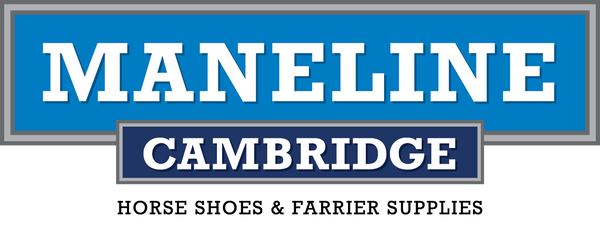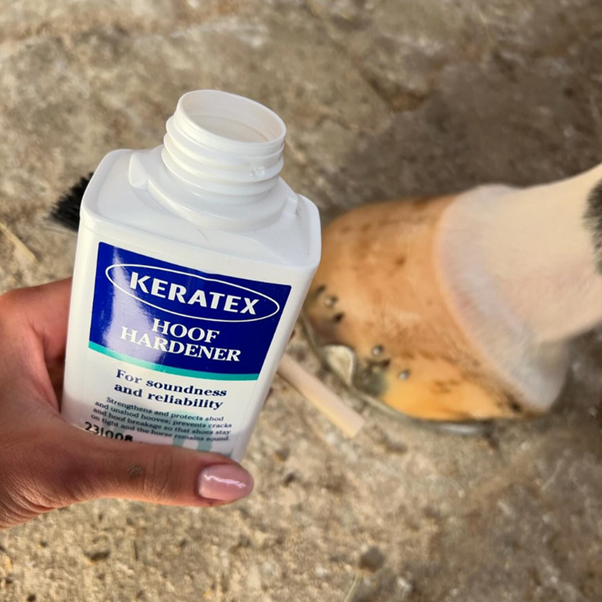As a farrier, I work with horses in all conditions, barefoot, shod, transitioning, or just plain tricky. One product that consistently comes up in conversations with my clients is Keratex Hoof Hardener. Whether I’m dealing with a horse that throws shoes, has soft soles, or one that’s making the shift to barefoot, this product has become a go-to recommendation in my career.
But don’t just take my word for it. I recently spoke with a few of my clients who use Keratex Hoof Hardener as part of their regular hoof care routine. Here’s what they had to say.
Interview 1: Olivia – Transitioning to Barefoot After Years in Shoes
Horse: “Milo” – 12-year-old Thoroughbred cross
Location:* Waikato, NZ
Condition: Transitioning from shoes to barefoot; thin soles, tenderness on gravel
Farrier: Olivia, what made you decide to take Milo barefoot?
Olivia: We retired him from low-level eventing and I wanted a more natural lifestyle for him. Plus, he was always losing shoes in the paddock. But I quickly realised how tender his soles were without the shoes, especially on our gravel drive. I knew I needed something to help his hooves toughen up naturally.
Farrier: When did you start using Keratex Hoof Hardener?
Olivia: About two weeks into our barefoot journey. I’d read some recommendations in barefoot Facebook groups and figured I had nothing to lose. Within a week, I saw improvement. He wasn’t flinching on hard surfaces as much, and by the third week, we were confidently hacking on all our regular tracks.
Farrier: How often do you apply it?
Olivia: At first I applied it every other day. Now I use it once or twice a week for maintenance. The bottle lasts surprisingly well, I’ve still got my first one three months on.
Farrier: Would you recommend it to others transitioning to barefoot?
Olivia: Absolutely. Keratex Hoof Hardener gave me confidence that I could go barefoot without compromising my horse’s comfort. I even took his hoof boots off last week for the first time on the road. Big moment!
Interview 2: Mark – Battling Brittle, Cracked Hooves in a Hard-Working Sport Horse
Horse: *“Echo” – 10-year-old Warmblood gelding
Location: Canterbury, NZ
Condition: Frequently cracked hooves, prone to throwing shoes, wet paddocks
Farrier: Mark, Echo’s hooves have always been a challenge. What finally made you try Keratex Hoof Hardener?
Mark: Honestly? Frustration. I was constantly ringing my farrier, to put shoes back on. Echo works five / 6 days a week and his hooves and soles were soft and were getting worse, especially after winter. I was looking for something to harden the hoof wall and stop the shoes from getting pulled off in the mud.
Farrier: What’s been your experience since you started using it?
Mark: Game-changer. I noticed the cracks started looking more stable after about two weeks, and now the hoof wall holds nails better. He hasn’t lost a shoe since. That’s unheard of for this horse!
Farrier: Do you use any other products alongside it?
Mark: I keep things simple. Just a good feed with biotin and regular trims. But honestly, Keratex Hoof Hardener did most of the heavy lifting and I noticed results in around a week, plus the product dries quickly too, no mucking around waiting before turnout.
Farrier: Would you say the Keratex Hoof Hardener works well in wet conditions?
Mark: Yes. Especially since it doesn’t seal the hoof completely, it still lets the hoof breathe. That’s important in the wet Canterbury winters. Other products I’ve tried just left things sticky or made no difference.
Why I Recommend Keratex Hoof Hardener as a Farrier
In my line of work, I see a wide range of hoof conditions, and one thing is certain: a compromised hoof limits everything, from training to turnout. Keratex Hoof Hardener has proven itself across different use cases, from barefoot transitions to shod sport horses. What sets it apart is that it doesn’t just coat the hoof, it chemically reinforces the keratin structure, giving real strength to both wall and sole.
Common Questions I Get About Keratex Hoof Hardener
Does Keratex Hoof Hardener really work for soft soles?
Yes. Horses with soft or tender soles, especially those just out of shoes, often need time to rebuild natural sole callus. Keratex Hoof Hardener speeds this up by hardening the sole tissue without damaging live tissue underneath.
Can it be used on barefoot horses?
Absolutely. It’s safe and effective for barefoot horses. It’s a fantastic tool during the transition period or for ongoing maintenance in challenging environments like gravel or wet pastures.
How often should I apply it?
Start with 2–3 times per week and then reduce to once a week for maintenance. It depends on the individual horse, climate, and hoof condition. I always say consistency is key.
Is it safe in wet weather?
Yes, it’s one of the few products I trust in muddy, damp conditions. Because it doesn’t form a complete barrier, the hoof stays dry but breathable, ideal for wet New Zealand winters.
Final Thoughts
Hoof health is everything. If your horse has soft soles, brittle walls, or you’re making the shift to barefoot, Keratex Hoof Hardener is one of the best investments you can make. It strengthens, supports, and saves money in the long run,fewer lost shoes, fewer vet visits, and more confident steps from your horse.
If you’re unsure whether it’s right for your horse, talk to your farrier. Chances are, we’re already recommending it.

